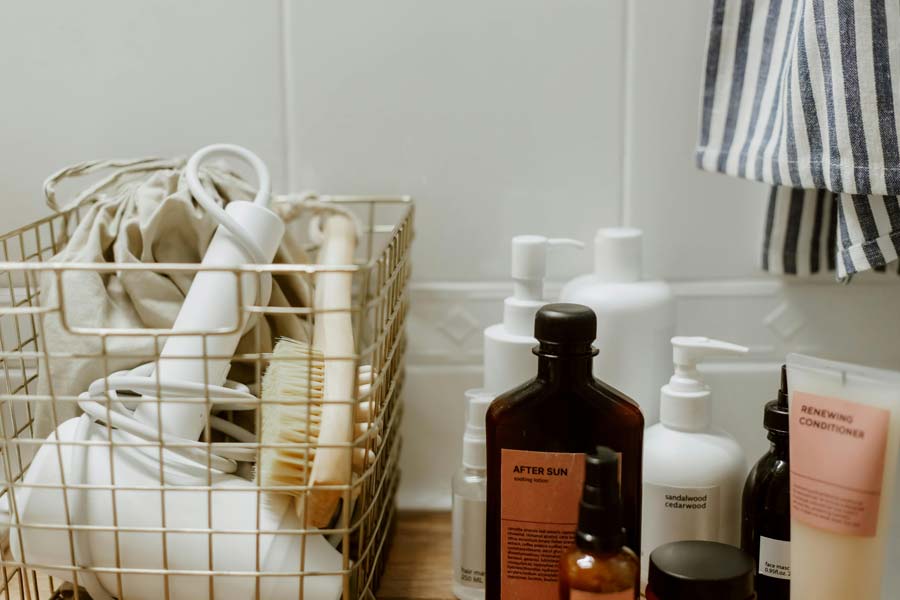The beauty industry is booming. In the quest for shiny hair and flawless skin, many of us stock our bathrooms with a dizzying array of products, which often promise a ‘radiant complexion’ or ‘age-defying’ results. But behind the glossy labels lies a concerning truth: many everyday products contain toxic beauty ingredients that could be harming your health.
The Hidden Dangers in Your Beauty Routine
Studies suggest the average woman uses around 12 personal care products every day, such as
shower gel, skin lotions, deodorant, lipstick and hairsprays, exposing herself to around 168 unique ingredients. For men, it’s around six products containing up to 85 chemicals.
Not all chemicals are harmful; many are essential for maintaining product stability or performance. However, there are many toxic beauty products with substances that raise red flags. These contain ingredients which may cause skin irritation, disrupt hormone balance, or even contribute to long-term health issues.
Did you know compounds from these products can stay on the skin for weeks despite daily washing? Or that just one application has the potential to alter the skin chemistry?
It’s time to take a closer look at what we’re putting on our skin, and what it might be doing beneath the surface.
Why You Should Be Concerned About Toxic Beauty Ingredients
The skin is the body’s largest organ, and it’s not an impermeable barrier. Many of the substances applied to the skin are absorbed directly into the bloodstream. That means your daily skincare routine might be doing more than just moisturising your face, as it could be introducing toxins into your system.
The Good: Beneficial Ingredients That Support Skin Health
Not all ingredients are bad. Many products include beneficial compounds that support skin health.
- Hyaluronic acid helps retain moisture and keep skin plump.
- Antioxidants like Coenzyme Q10, bakuchiol, and vitamins C and E help protect the skin from free radicals, which can accelerate ageing.
The Bad: Study Reveals Widespread Use of Hazardous Ingredients
A 2019 study in the Journal of Preventive Medicine and Hygiene analysed 283 skincare products from stores in Lecce, Italy. Products were categorised into rinse-off, leave-on, and make-up groups. The labels were examined for the presence of preservatives, fragrances, and chemicals of concern.
- 58% of products contained at least one ingredient of concern..
- PEGs (polyethylene glycols) were found in 62.3%, and acrylate copolymers in 34% of products.
- In the Makeup category, 64.7% contained hazardous ingredients, including acrylates (45.2%) and petrolatum (33.3%).
The researchers warned that leave-on and make-up products posed a greater risk, as they stay on the skin longer and are often applied near delicate areas, such as the eyes and lips.
The Ugly: Toxic Beauty Ingredients to Avoid
Understanding ingredient labels is essential. Here are some of the most concerning toxic beauty ingredients commonly found in skincare and cosmetics:
Parabens
Synthetic preservatives like methylparaben, ethylparaben, propylparaben, and butylparaben are widely used in cosmetics and skincare products to prevent bacterial growth and mould, and extend their shelf life. They have come under scrutiny due to their potential to mimic oestrogen in the body. Research suggests they could cause hormonal disruption and even impact reproductive health. While the scientific community continues to investigate the long-term effects, many consumers are choosing to avoid products containing these preservatives.
Phthalates
These are a group of chemicals used to improve texture and help scents last longer. Phthalates, such as DBP (dibutyl phthalate) and DEP (diethyl phthalate), are found in nail polish, hair spray, and scented lotions. They have been linked to reproductive and developmental toxicity, especially in males. And, they are also suspected endocrine disruptors, which may contribute to infertility and other health issues. Watch out for vague terms like ‘fragrance’ or ‘parfum,’ which may hide phthalates.
Formaldehyde and Formaldehyde-Releasing Agents
These are found in nail hardeners, hair treatments and some skin products. Ingredients like DMDM hydantoin, imidazolidinyl urea and quaternium-15 release small amounts of formaldehyde over time. It is worth remembering that formaldehyde is a known carcinogen, and exposure to this chemical has been associated with skin irritation, allergic reactions, and respiratory issues.
Sodium Lauryl Sulfate (SLS) and Sodium Laureth Sulfate (SLES)
These are surfactants commonly used in products such as shampoos, cleansers, and toothpaste to create a foaming effect. While these chemicals effectively remove dirt and oil from the skin, they can also strip away the skin’s natural oils, leading to dryness and irritation. Individuals with sensitive skin may experience increased sensitivity and redness.
Synthetic Fragrances
While a pleasant scent can enhance the overall experience of a product, fragrances are often composed of various chemicals which may cause skin sensitivities or allergies. For this reason, the EU established limits on their use and an obligation to list their presence on product labels, if the concentration is higher than 0.01% in rinse-off products and 0.001% in leave-on products. Look out for products labelled ‘fragrance-free’ or ‘made with essential oils.’
Cumulative Exposure: Why Small Doses Still Matter
One-time exposure to a harmful ingredient may not have a significant impact. But think about how many products you use each day, from shampoo, conditioner, body wash, face wash, toner, serum, moisturiser, sunscreen, foundation, lip balm, mascara…the list goes on. Each of these may contain small amounts of toxic ingredients. Over time, cumulative exposure can add up, especially if you apply them daily for years.
How to Protect Yourself from Harmful Beauty Ingredients
You don’t need to ditch your entire beauty routine, but just make smarter swaps. Here’s how to reduce your exposure to harmful ingredients without the overwhelm.
Read Ingredient Labels Carefully
Just like checking food labels, take a moment to scan your cosmetics. Apps like EWG’s Skin Deep or Think Dirty make it easier to decode complex ingredients.
Simplify Your Skincare Routine
Less is more. Using fewer products not only reduces chemical exposure but also saves money and simplifies your routine.
Support Clean Beauty Brands
While no brand is perfect, many are committed to safer formulations—look for those that prioritise transparency and non-toxic ingredients.
Final Word on Toxic Beauty Ingredients
Beauty shouldn’t come at the expense of your health. By avoiding toxic beauty ingredients and opting for cleaner alternatives, you can protect your body while still enjoying glowing skin. Read labels, simplify your routine, and prioritise wellness from the inside out.
https://pubmed.ncbi.nlm.nih.gov/31189482/
https://pubmed.ncbi.nlm.nih.gov/21212847/
https://www.ncbi.nlm.nih.gov/pmc/articles/PMC2726844/
https://jamanetwork.com/journals/jamadermatology/fullarticle/2751513
https://www.ncbi.nlm.nih.gov/pmc/articles/PMC6477564/
https://www.ncbi.nlm.nih.gov/pmc/articles/PMC6477564/#ref11




